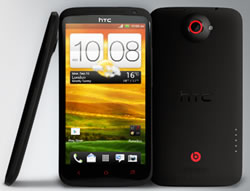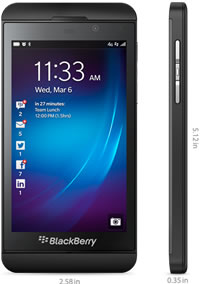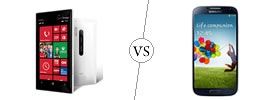Difference between HTC One X+ and BlackBerry Z10
Key Difference: The HTC One X+ sports a 4.7-inch super LCD 2 touch screen with approximately 312 ppi pixel density, meaning the screen is pretty awesome and it does not show any pixels. The device is powered by 1.7 GHz Quad-core NVIDIA Tegra 3 process making it faster than the original HTC One X. The Blackberry Z10 is the latest smartphone that has been released in January 2013 by Research in Motion. The Z10 is a bar phone that is available with a 4.2 inch capacitive touch screen that has approximately 355 ppi pixel density, providing a clear and sharp display. If supports a 1.5 GHz Dual-core Krait, 2GB RAM with 16 GB internal storage capacity and expandable capacity up to 64 GB.

HTC is a popular smartphone company and has been touted for many beautifully designed phones. The phones are smart, sleek and to the point with no extra marketing gimmick. HTC maintains this with the launch of the HTC One X+. The HTC One X+ is a new phone that shares many similarities to its big brother the HTC One X; however, it also shines in many places where the predecessor shied. The HTC One X+ is basically an upgraded version of the HTC One X and hit the market in November 2012.
The HTC One X+ sports a 4.7-inch super LCD 2 touch screen with approximately 312 ppi pixel density, meaning the screen is pretty awesome and it does not show any pixels. The screen has excellent resolution and shows sharp and crisp clear photos and videos. The screen is protected by Corning Gorilla Glass 2 that keeps it from getting minor day-to-day scratches. The device is sleek and thin in general, but has put on a little extra weight (5 grams) compared to the original One X. The phone is covered in a soft-touch polycarbonate plastic chassis that has smooth curved corners. The soft matte plastic makes it easy to grip the phone and keeps it from slipping through the fingers. The phone comes incorporated with the HTC Sense UI v4+, which is basically a combination of the HTC Sense and Jelly Bean. The combination of the two provides additional features such as: Google Now, Voice search, faster screen navigation, new gallery app (organizes photos by events and location) and HTC Get Started (allows PC to configure the phone faster).
The device is powered by 1.7 GHz Quad-core NVIDIA Tegra 3 process making it faster than the original HTC One X. The faster processor allows seamless transitions between apps and makes the device smooth to work with. There was no hindering or jerking when operating the device. The One X+ comes installed with Android v4.1 (Jelly Bean) right out of the box. The device comes with 32 and 64 GB internal storage capacity that is not expandable and 1 GB RAM.
The device houses an 8 MP rear camera with auto focus, LED flash, and BSI sensor, along with a 1.6 MP front camera for video conferencing. The front camera also has a countdown features that counts down to the moment the picture is being taken to ensure that the user is camera ready. The camera comes with many additional features that help the phone stand out against all the other devices. The features include: F2.0 aperture and 28mm lens, Dedicated HTC ImageChip, VideoPic, Continuous shooting, Smart Flash, Sightseeing mode, Video stabilization, Slow motion video capture and playback and ImageSense. The ImageSense allows the phone to take faster and the best photos under any lighting. The VideoPic is a new feature that allows users to take images while recording a video as well as taking an image when playing an already recorded video. The Smart Flash provides five levels of flash that adjust automatically when trying to take a shot, while the Sightseeing mode allows the camera to be handy during outings, so that it can be easily accessible.
The device houses a non-removable 2100 mAh Lithium-ion Polymer battery, which according to tests by many review website, dies pretty quickly. When fully-working the battery does not even last a whole day. However, no official data has been released by the company regarding the Talk-time and the Stand-by time. The company has also added the Beats Audio sound enhancement to its speakers as well as headset and it can be turned on and off by the user. The phone has been a popular hit with many that require a good sturdy budgeted phone with an excellent camera.
 The Blackberry Z10 is the latest smartphone that has been released in January 2013 by Research in Motion. The phone is powered by the company’s BB10 and is believed to be the company’s latest attempts to capture the smartphone market. The Z10 is a bar phone that is available with a 4.2 inch capacitive touch screen that has approximately 355 ppi pixel density, providing a clear and sharp display. The phone is also light in weight and perfect for one-hand operation. If supports a 1.5 GHz Dual-core Krait, 2GB RAM with 16 GB internal storage capacity and expandable capacity up to 64 GB. The Z10 has an 8MP auto-focus camera along with 2MP front-facing camera for video conferencing. The camera offers a new Time Shift mode that allows users to pinpoint and adjust individual elements of a picture.
The Blackberry Z10 is the latest smartphone that has been released in January 2013 by Research in Motion. The phone is powered by the company’s BB10 and is believed to be the company’s latest attempts to capture the smartphone market. The Z10 is a bar phone that is available with a 4.2 inch capacitive touch screen that has approximately 355 ppi pixel density, providing a clear and sharp display. The phone is also light in weight and perfect for one-hand operation. If supports a 1.5 GHz Dual-core Krait, 2GB RAM with 16 GB internal storage capacity and expandable capacity up to 64 GB. The Z10 has an 8MP auto-focus camera along with 2MP front-facing camera for video conferencing. The camera offers a new Time Shift mode that allows users to pinpoint and adjust individual elements of a picture.
The users can interact with the OS using gestures such as swipe, tap, pinch, and reverse pinch. The phone comes with a few new features such as Hub, Balance, Story Maker and Remember. The Hub is a screen that is available by swiping left after the first menu page and task switcher and it is creates a single point where the user can check all updates from SMS, e-mail to facebook notifications. It also offers the users to post messages, update twitter, facebook and any other services. BlackBerry Balance is a feature that allows people to separate their work life from their personal life. It allows easy access to creating two separate profiles, where work related and personal related profiles can be kept separate and maintained. Story Maker is an app that allows users to create a story by selecting photos and an audio clip to go along with it. The app will automatically create a video and will also include effects. The new keyboard on the Z10 has an adaptive feature that learns as the user types words and also suggests future words that can be used making typing e-mails and messages easier. Many reviews do state that one of the downfalls of the phone is the camera as well as lack of apps. The camera is not as sharp as it could be and the phone does not offer many apps in the BlackBerry World store.
The information for the detailed table about the two phones has been taken from HTC website, Blackberry website and GSMArena.com.
|
|
HTC One X+ |
BlackBerry Z10 |
|
Launch Date |
November 2012 |
January 2013 |
|
Company |
HTC |
Research In Motion |
|
Size |
134.36 x 69.9 x 8.9mm |
130 x 65.6 x 9 mm |
|
Display |
4.7 inch super LCD 2 touch screen |
4.2 inches capacitive touchscreen |
|
Screen |
720 x 1280 pixels (~312 ppi pixel density) |
768 x 1280 pixels (~355 ppi pixel density), 16 million colors |
|
Protection |
Corning Gorilla Glass 2 |
Password protection, screen lock, and sleep mode, BlackBerry® Balance™ offering dedicated profiles to keep work and personal data separate and secure. |
|
Weight |
135 grams |
137.5 g (4.83 oz) |
|
2G Network |
GSM 850 / 900 / 1800 / 1900 |
GSM 850 / 900 / 1800 / 1900 - all versions |
|
3G Network |
HSDPA 850 / 900 / 1900 / 2100 HSDPA 850 / 1900 / 2100 - for AT&T |
HSDPA 850 / 900 / 1900 / 2100 - STL100-1 HSDPA 850 / 900 / 2100 - STL100-2 |
|
4G Network |
LTE 700 MHz Class 17 / 1700 / 2100 - for AT&T |
LTE 800 / 900 / 1800 / 2600 - STL100-2 |
|
GUI |
HTC Sense UI v4+ |
Blackberry UI |
|
CPU speed |
1.7 GHz Quad-core NVIDIA® Tegra® 3 |
1.5 GHz Dual-core Krait |
|
GPU |
ULP GeForce 2 |
Adreno 225 |
|
OS |
Android OS, v4.1.1 (Jelly Bean) |
BlackBerry 10 OS |
|
Chipset |
NVIDIA Tegra 3 AP37 |
Qualcomm MSM8960 Snapdragon |
|
RAM |
1 GB |
2 GB RAM |
|
SIM Size |
microSIM |
microSIM |
|
Internal Memory |
32/64 GB |
16 GB |
|
Expandable Memory |
No |
Up to 64 GB |
|
Sensors |
Gyro sensor, G-Sensor, Digital compass, Proximity sensor, Ambient light sensor |
Accelerometer, magnetometer, proximity sensor, gyroscope, ambient light sensor |
|
Connectivity |
3.5 mm stereo audio jack, NFC capable, Compliant with Bluetooth 4.0, Bluetooth with aptX™ enabled, Wi-Fi®: IEEE 802.11 a/b/g/n, DLNA®, micro-USB 2.0 (5-pin) port with mobile high-definition video link (MHL) for USB or HDMI connection |
Wi-Fi, 2G, 3G, 4G, NFC, Bluetooth 4.0 and microUSB 2.0. |
|
Data |
GPRS, EDGE, WLAN, Bluetooth, NFC, USB. |
GPRS, EDGE, WLAN, Bluetooth, NFC and USB |
|
Speed |
HSDPA, 21 Mbps; HSUPA, 5.76 Mbps - Global version / HSDPA, 42 Mbps; HSUPA, 5.76 Mbps; LTE |
HSDPA 21 Mbps, HSUPA 5.76 Mbps; LTE, EV-DO Rev. A, up to 3.1 Mbps |
|
WLAN |
Wi-Fi 802.11 a/b/g/n, dual-band, DLNA, Wi-Fi hotspot |
Wi-Fi 802.11 a/b/g/n, dual band |
|
Bluetooth |
Bluetooth v4.0 with A2DP |
Bluetooth v4.0 with A2DP, LE |
|
USB |
microUSB v2.0 (MHL) |
microUSB v2.0. |
|
Primary Camera |
8 MP camera with auto focus, LED flash, and BSI sensor |
8 megapixel auto-focus camera |
|
Secondary Camera |
1.6 megapixel front camera (720p for video recording) |
2 megapixel fixed-focus camera with image and video stabilization, 3x digital zoom and 720p HD video recording |
|
Video |
1080p HD video recording |
1080p HD video recording with 4 DOF (Degrees of freedom) video stabilization |
|
Camera Features |
|
|
|
Sound Enhancement |
Beats Audio |
No |
|
Audio supported formats |
.aac, .amr, .ogg, .m4a, .mid, .mp3, .wav, .wma |
3GP, 3GP2, WMA, MP3, MKA, AAC, AMR, F4V, WAV, MP2PS, MP2TS, AWB, OGG, FLAC |
|
Video supported formats |
.3gp, .3g2, .mp4, .wmv (Windows Media Video 9), .avi (MP4 ASP and MP3) |
M4A, M4V, MOV, MP4, MKV, MPEG-4, AVI, ASF, WMV, |
|
Battery Capacity |
Non-removable 2100 mAh Li-ion Polymer battery |
Li-Ion 1800 mAh battery |
|
Talktime |
No official data released |
3G: Up to 10 hours |
|
Standby Time |
No official data released |
3G: Up to 13 days (312 hours) |
|
Available Colors |
Black, White |
Black, white |
|
Messaging |
SMS(threaded view), MMS, Email, Push Mail, IM, RSS |
SMS, MMS, Email, Push Email, IM, BBM 6 |
|
Browser |
HTML5, Adobe Flash |
HTML5 |
|
Radio |
Stereo FM radio with RDS |
No |
|
GPS |
GPS with A-GPS support and GLONASS |
Yes, with A-GPS support |
|
Java |
Java with Java MIDP emulator |
MIDP 2.1 |
|
Additional Features |
|
|
Image Courtesy: htc.com, us.blackberry.com









Add new comment